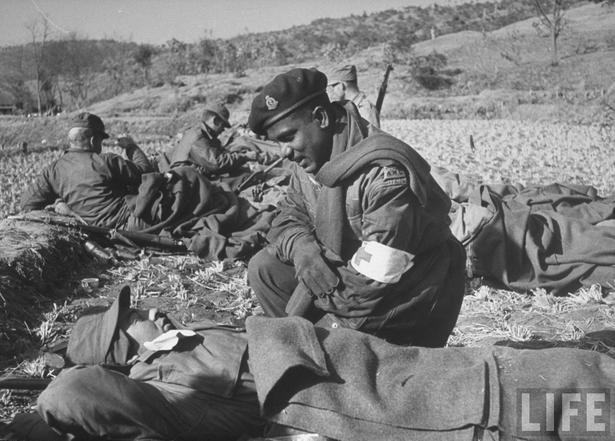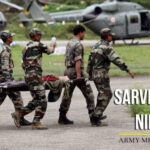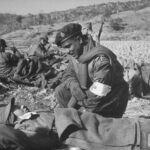It is the perception that a war Hero can only be the infantry rifle or Machine gun wielding individual or a tank man or Air force fighter pilot. Stethoscope man usually does not fit in this perception in the public eye. This perception needs to be negated by the medical service men, veterans, media and newspapers to highlight that the gentle physician, in army language, regimental medical officer look after the health of the troops, sick and wounded in the adverse life threatening environment of Siachen high altitude, Himalayas Leh-Ladakh, Kargil –Daras, Joshi math, Mana-Malari, Rajouri- Poonch and many places in the eastern sector in India. This peace time service is further dangerously, compounded during the war. There are many inspiring stories of bravery and courage under the fire of ballistics by the medical officer and other rank of the Army medical Corps which remains under the dust of the battlefield. Myself as medical veteran having served the operations of 1971, Kargil 1990 and operation Parakram 1999 to 2000 feel proud to publish the comprehensive story of the regimental medical officer captain Suresh Murthy during 1971 Eastern sector Bangladesh war. Captain Suresh Murti later retired as Brigadier, my batch mate of BMOC 1968 has written the brilliant comprehensive medical management along with the war diary of his involvement. Regimental medical officer (RMO) is the medical officer, qualified general medical practitioner posted to the forward field area with additional training in pre- Hospital emergency, resuscitation skills, water care and hygiene services, environmental and occupational medicine Healthcare. This is the first direct contact of the medical officer with the fighting arms and services personels. This is also an opportunity to understand the fighting Soldier, armaments used in the war, it’s Lethal effects psychology- physiology and the overall health care needs of the troops. Usually 200 to 300 regimental medical officers are deployed at forward fighting battalions in India.
Similar number of medical officers are posted at back –e-ecchlons of resuscitation evacuation of Advance Dressing stations (ADS) to field ambulance, Base hospitals of armed forces Medical Services. Deployment in the field of the medical officer is a difficult task though authorised on the posted strength, needs the skill to understand the war situation and contact with the enemy. Infantry may be the priority whereas armoured or air defence with split squadrons could depend on the advance dressing stations (ADS). However, allotment could never be a perfect system which needs the involvement of local Medical and non-medical commanders who are in knowledge of military operational situation.
History of Indian medical service (IMS) dates back to 1612 with the formation of East India Company with the civilian medical officers individual contractual model. Till first World War IMS was predominantly civil in character. Indianization of this service commenced from 1915 onwards. Sarfoo Coomargoodeve Chanckerbuty was the first Indian to enter the service as assistant surgeon on 24 January 1855. Civil and military needs, predominantly the Civil medical officers, continued till 1935. Medical corps exclusively for the Defence Services was conceived in 1939 with the outbreak of second world war and with the time it took the shape of Indian Army medical Corps on 3rd April 1943. It was the amalgamation of IMS, IMD and finally Indian hospital service merged to form IAMC with HQs at Pune in May 1943. IMS service from 1612 to 1943 which slowly decreased to extinction, lasting three centuries, their contribution is merely a matter of history. Indian troops neither had system of station hospitals nor the services of the Army Hospital native crops. Rudimentary medical care provided to them was the regimental medical officer civilian contractual model (IMS) with so-called, regimental Hospital (non0dicted). Regimental hospital was a small accommodation, ill-equipped, without nursing, without bearers, with one or two sepoys called orderlies dependent on QM small services In 1918, station hospital for Indian troops were sanctioned. Indian Army medical Corps (IAMC) was re- designated as Army medical Corps with effect from 26 January 1950. DGA FMS was given the responsibility of coordinating the needs of three services, Army, Navy and Air force.
Early days the activities of the IMS officer were indeed inclusive of non-professional such as Telegraph, post Masters, Political agents, School Superintendent, commissioner and forest Conservators. They played a significant role in forest and veterinary. later part of 19th century IMS officer begin to concentrate more and more on medical work alone. Therefore regimental medical officer (IMS Civil Contractual model) does not fit to the present status of equivalent in the armed forces. Colonel Blackhamet al (1920) reported the regimental medical officer. His powers and duties in Brit Med journal. Those medical officers
- RAMC were required to undergo the preliminary course followed by an internship of six to eight weeks under the experienced RMO possibly in a training camp. This would help the newly joined medical officer to put into practice the theoretical knowledge he had gained at the training centre. RMO should be a good mixer and be respected by both the officers and men having satisfactory contact with the men, the RMO should endeavor to be equally successful in his dealings with the commanding officer. Never forget that he is an expert employed in an advisory capacity. His sound medical knowledge and judgment should convince the commanding officer to keep the ADMS benevolent supervisor over the medical arrangements of the regiment following is the list of duties of a unit medical officer.
- Sanitary inspection:- comprehensive visit of the unit lines, cook houses, field kitchens, latrines and QM stores (availability of the anti-infective detergents).
- Choosing and inspection of the water supplies.
- Inspection of men going on leave, courses, or transfer to the base with emphasis on eliminating the communicable diseases such as skin infections.
- First aid classes to the men, stretcher- bearers and reserves.
- Training of sanitary and water duty, men and reserve to replace casualties.
- Clerical work – triage.
- Daily Sick report.
It is mandatory to identify those who are really sick and advised treatment at the unit medical inspection room *MI Room) with rest in the unit lines. There are others with minor ailments or small dressing would require M and D- medicine and duty. Those needing hospital treatment are mark “Hospital” and all further steps are taken by NCO in-charge for evacuation followed by the RMO visit to the hospital to these patients. Men who are not well enough to drill but who can perform light work in the barracks room are usually marked LD or light duty. Finally there may be small number in the sick report “without a cause” should be warned but if they persist in reporting Sick, should be marked “Duty” or in army language malingering chargeable under the army act. Here a word of caution to the RMO, his opinion must be definite and
substantiated prior to labelling. Earlier days a dose of castor oil or a number 9 tablet, sometimes, used to work wonder’s in cooling a man’s ardour for the sick parade. Sickness having direct connection with the cooking or sanitary arrangements of the regiment should be investigated and reported.
Why it is called daily Sick report parade that the Sick were first paraded at the regimental office, in front of Adjutant’s room, then marched up to the medical inspection room. This has a bearing on the health of the troops in the regiment assessed regularly in the reports and returns. Burges 1941 reported the impressions of a medical officer that a battalion medical officer rarely gets enough work for an experienced MO during peacetime deployment. Therefore, better medical work facility particularly, transit camps, station reception centres, recruitment centres, arms and services training centres should be considered as additional workload. Short spells in hospital would be welcomed by all RMO’s as would post graduate courses arranged in conjunction with various teaching hospital or base hospitals or command hospitals. The Indian Army medical Corps has been involved in almost all active combat operations and wars, the Indian Army has participated as part of combat formation or hospitals providing life and Limb saving Medical Services. Regimental medical officers of the Corps have been the dare devil medical heroes. First world war documented Victoria cross to the regimental medical officer serving with Dogra Battalion (now mechanized infantry battalion) 80 parachute fd ambulance commanded by lieutenant colonel Davis along with medical officer serving 152 Indian para battalion and 153 Gurkha para battalion were awarded several gallantry Honours in 1941 during Second World War (Sangshak-Imphal operations). Captain S Gopal Krishnan earned military cross on November 1944 during Second World War, Japanese action on Tiddim road mile 98.4 citation of the officer, serving 3rd Battalion,
5th Gorkha Rifles, the unit was dangerously pinned down by Japanese troops, the regimental medical officer worked round the clock for four days providing medical assistance and relief to the wounded saving nearly 100 lives. Captain Gopalakrishnan, retired as Brigadier later in the Indian Army.
60 para ambulance battalion as part of 50 independent para Brigade joined the UN forces in Korea in 1950. Their engineering innovation of an ancient locomotive to life and chugged across the last Bridge South before it was blown off salvaged the precious equipment and lives of troops, something no medical Training Centre teaches. It’s commanding officer lieutenant colonel A.G.Rangaraj and 60 para fd ambulance participated in UN operation Tomahak, the largest air bone operation of the war in Korea. Behind the Enemy Lines they worked on casualties with clock work efficiency carrying out some 103 surgeries an outstanding feat under the circumstances. US commander later commented that at least 50 of those operated upon owed their lives to the Indians, it is well documented, The officers and men of the unit were decorated with many awards for their exceptional gallantry which included 2 Mahavir Chakras, 6 Vir Chakras, 1 bar to Vir Chakra. There were 25 mention- in- despatches, a record for a unit, yet to beat till to-date.
It will be injustice if we do not pen down a few lines for A.G. Rangaraj, the youngest officer lieutenant was the regimental medical officer of 152 Indian para battalion, later commanded 60 para fd ambulance and awarded Mahavir Chakra in Korean War. He was the first Indian to make a parachute jump accompanied by Havildar Major Mathura Singh. His dare devil is well documented in Frontier wars of the north west and Japanese action (1944) during Second World War.
Two other officers of the 60 para fd ambulance who were in action during operation Tomahawk with Rangaraj were Major (later Major general) V Rangaswamy and captain NC Das. Rangaswamy had Bar to Vir Chakra, he had already decorated Vir Chakra for his legendary performance in Kashmir during 1947- 48 when he carried out several Limb saving surgeries under blackout conditions. Captain NC Das (later Brigadier) retired as anaesthesiologist.
Those who have been awarded Mahavir Chakras, from the Army medical Corps, the second highest gallantry award were
Lt Col A.G.Rangaraj
Maj (Lt Col) Anil Krishna Barat Maj (col) Niron Baran Banerjee Capt Pratap Singh (Posthumous)
Indo China 1962 War, the Army Medical corps officers and men facing incredible odds to attend to casualties putting themselves in the line of fire a chaos prevailed.
There was breakdown of command and control, several doctors and nursing staff took it upon themselves to stay back and attend to casualties rather than desert them when the units they were with abandoning their positions. The courage and dedication of two regimental medical officers Captains Raja Amritha Lingam and E.N.Iyengar has been well documented in medical history. Captain Raja Amritha Lingam was (POWs) in captivity of Chinese in Ladakh and E.N.Iyengar regimental medical officer 1 Madras was at last hold out unit Bomdila North East Frontier NEFA. Both the regimental medical officers were decorated with Vir Chakras on release.
Sepoy S. Joseph and nursing assistant Dharmpal Dahiya of Army medical Corps are the Vir Chakra awardees for exceptional courage and bravery in service of sick and wounded at the forward posts during Chinese aggression. Vir chakras were awarded posthumously. Since Independence more than a dozen Vir Chakras have been awarded to the officers and men of Army medical Corps but rarely highlighted by the armed forces Medical Services or the arms and services leader at various military functions at Sainik Samelans.
The Army medical Corps has won a number of peacetime gallantry awards such as sena medals, Surya chakras and distinguished service Vishisht Seva Medal, Army commanders commendations, Mention and Dispatches etc awards during counter insurgency or Anti Terrorist operations. Major Laishram JYOTI Singh, a shining example of bravery. On 26 February 2010 sacrificed his own life in anti -terrorist attack on Kabul embassy to save the damage and loss of life of others- awarded Ashok Chakra the nation’s highest peace time gallantry award. He was regimental medical officer of the Kabul embassy.
CONCLUSION:-
History of Indian medical service IMS started with the appointment of John woodell as the surgeon general with East India company in 1612. Civilian medical officers were recruited as individual contractual model. IMS was primarily for 3 Bengal, Madras and Bombay, Presidency Armies but civilian needs were catered inclusive of non- professional activities. It was only latter part of 19th century that these medical officers concentrated to professional medical work. Indian medical service continued three centuries (1612- 1943) till exclusive for defence medical service separately the Army medical Corps.
Royal Army medical Corps appointed early nineteenth-century regimental medical officers. These officers required to undergo preliminary six to eight weeks training with internship under the experienced station camp regimental medical officer. One medical officer serving the Dogra battalion earned Victoria cross. Captain
S. Gopalakrishnan was honoured with military cross in 1944. Army medical Corps appointed regimental medical officers and surgical teams to the forward areas during the combat operations. Major V Rangaswamy was the first after independence to be honoured with Vir Chakra for exemplary performance as a surgeon under blackout conditions during 1947- 48 Kashmir invasion by Pakistan. He earned bar to Vir Chakra along with captain NC Dass, Veer Chakra, while serving 60 para fd ambulance during Korean War. Captain Raja Amrithalingam and E N Iyengar were decorated with Vir Chakra for duty beyond call and bravery during Indo-China operations 1962. Similarly Army medical Corps dedicated soldiers Sepoy S Joseph and Nur assistant Dharmpal Dahiya were honoured posthumously with Vir Chakra in 1962 for exceptional performance and dedication to the sick and wounded, 80 parachute fd ambulance, during 2nd world war (1941) and 60
parachute fd ambulance during Korean war, UN forces were awarded several gallantry awards in 1941 and 1950 simultaneously a record for a unit yet to beat till to date. Army medical Corps has won a number of peace-time gallantry awards such as Surya Chakra, Sena medal and distinguished service awards such as vishisht Seva Medal, Mention and dispatches, army commanders Commandations. Major Lai Shram Jyotin Singh, regimental medical officer to Kabul Embassy was decorated with Ashok Chakra, the highest peacetime gallantry award in 2010. Since Independence more than dozen Veer Chakra and other gallantry awards have been awarded to officers and other ranks of the Army medical Corps. These awardees are the inspiration to Army medical Corps, the true use spirit as SARVE SANTU NIRAMAYA.
PS Capt Naresh Parmar (later retired as Lieutenant General, DGAFMS Regimental Medical officer, 10 sikh, was awaeded virchakra in 1971. Recent 2021, President of India has awarded Nursing Assistant Naik Deepak Singh, Virchakra for providing medical care even after self injured in Galwan (ladakh) conflict with china his wife received posthmous virchakra to naik Nur-asst Deepak singh, an honour to Army Medical Corp.



